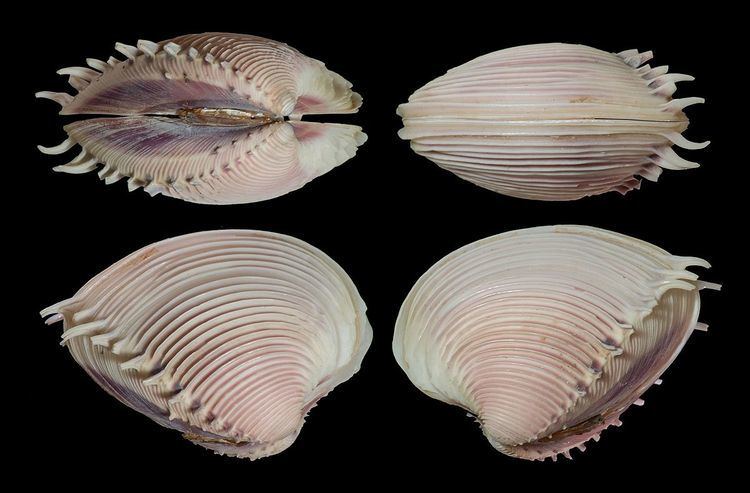Kingdom Animalia Class Bivalvia Family Veneridae Scientific name Pitar dione | Phylum Mollusca Order Veneroida Genus Pitar Rank Species | |
 | ||
Similar Pitar, Pitar lupanaria, Macrocallista maculata | ||
Pitar (Hysteroconcha) dione, or the elegant Venus clam, formerly known as Venus dione, is a species of bivalve mollusc in the family Veneridae, the Venus clams. The shell is whitish pink, with a row of long curved spines on each valve.
Contents
The species was named in Systema Naturae in 1758 by the Swedish naturalist Linnaeus. Both there and in his 1771 Fundamenta Testaceologiae, he described the shell in "disquieting[ly]" sexual terms.
Etymology
The species was named in 1758 by the Swedish naturalist Linnaeus as Venus dione, Venus being the name of the Roman goddess of love, and especially of sex.
The specific epithet dione is the name of the mother of Venus in Roman mythology. The later generic name Hysteroconcha is from Greek hyster, womb, and Latin concha, shell.
In human culture: the Venus shell
In his 1758 Systema Naturae, and then in his 1771 Fundamenta Testaceologiae, Linnaeus used a series of "disquieting[ly]" sexual terms to describe the shell: vulva, anus, nates (buttocks), pubis, mons veneris, labia, hymen. The evolutionary biologist Stephen Jay Gould called Linnaeus's description "one of the most remarkable paragraphs in the history of systematics". Some later naturalists found the terms used by Linnaeus uncomfortable; an 1803 review commented that "a few of these terms however strongly they may be warranted by the similitudes and analogies which they express, ... are not altogether reconcilable with the delicacy proper to be observed in ordinary discourse", while the 1824 Supplement to the Encyclopædia Britannica criticised Linnaeus for "indulg[ing] in obscene allusions."
Description
The shells of Pitar dione can reach a length of about 72 millimetres (2.8 in). The color of the whole shell is very pale or whitish pink, with whitish interior. The anterior end is broadly rounded, while the posterior is lightly sloping. The surface of each valve is characterized by several sharpened concentric and prominent ribs. This rare species is unusual in that it has a double series of long, curved spines on the posterior slope of each valve. A closely related species from the Eastern Pacific is Pitar lupanaria.
Distribution
This species is found in the Gulf of Mexico, from eastern Mexico to the West Indies.
Habitat
This species lives in intertidal zones and moderately shallow waters.
